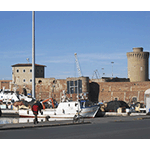Medici Port of Livorno
It was ordered by Cosimo I de' Medici, but built only in the years after his grand duchy. The original project provided for the construction of two parallel piers which were supposed to reach, respectively, the Fanale dei Pisani and the Old Fortress. The construction of the first arm, ordered by Ferdinando I, came to a halt sooner than expected, on the Sassaia reef, while the second was built under Cosimo II. The same years also witnessed the outfitting of the extensive dockyard opposite the Old Fortress and the completion of the navigable canal between Pisa and Livorno. Protected by a chain of rocks, removed in 1864, the port could not contain many vessels due to the shallow depth of water. Lazarettos were built some distance from the port to quarantine boats arriving from countries that might have spread epidemics.
Significant operations were conducted by the last Grand Duke of Tuscany, Leopold II. In 1852, he ordered the construction of an impressive curved wall, 800 metres from the old pier. 1130 metres long and an average of 8.50 metres deep, the new port was 400 metres from the Fanale dei Pisani. A canal was excavated in the middle of the old pier, to enable the transit of ships that had to enter the shipyard dock for repairs. Furthermore, in order to make communications between the sea and land and between ships and the railway easier and faster, he decided to build the harbour station. Designed by engineer Giuseppe Laschi, the construction of the station began in 1856: for this purpose, a vast tract of sea was filled, a four-sided dock was build for the convenience of boats, and large warehouses were erected along its sides where goods could be stored. On the land side, a building for offices was erected, while a smaller building was erected in the water to house the financial police. Before reaching the station of San Marco, the railway crossed the Navicelli Canal by means of an iron revolving bridge, reached the dock and then continued along the entrepôt piers. The harbour station was inaugurated on August 12, 1858.
The Medici port of Livorno is a scientific site associated with the name of Galileo Galilei. Between 1590 and 1592, don Antonio de' Medici proposed a machine to empty the dock of Livorno, and according to the account of Vincenzo Viviani in Racconto istorico, Galileo expressed a negative opinion.
The Pisan scientist also used the port for several experiments with the telescope. On March 22, 1617, Galileo wrote from Pisa to Curzio Picchena, describing the experiment conducted with the celatone, a device conceived to utilise the telescope onboard a ship, even with moderate seas. Galileo declared that he had been able to verify the effect of the spectacle only onboard a small boat inside the dock, as there were no vessels outside the dock. Though the wind was very strong, there was little wave motion and that little motion did not damage the use of the spectacle.
****************************
Texts by Graziano Magrini
English translation by Victor Beard
Last update 26/mar/2008




